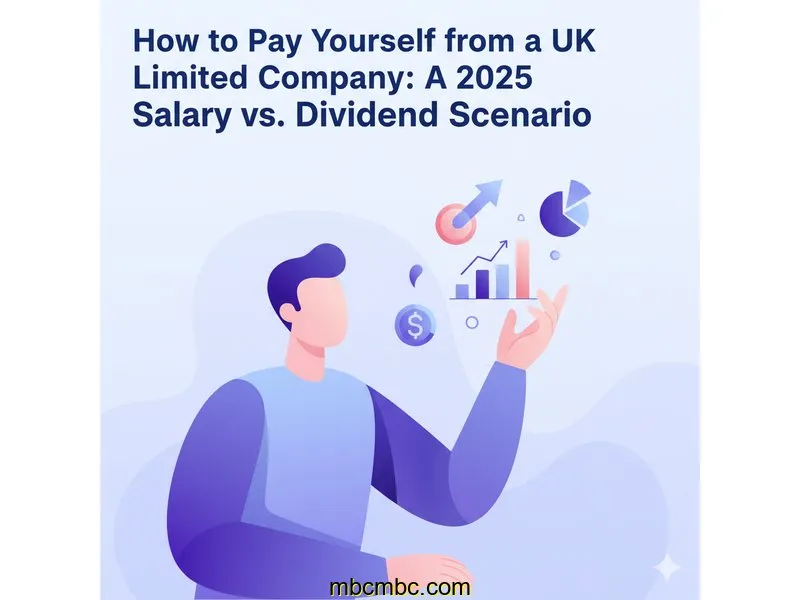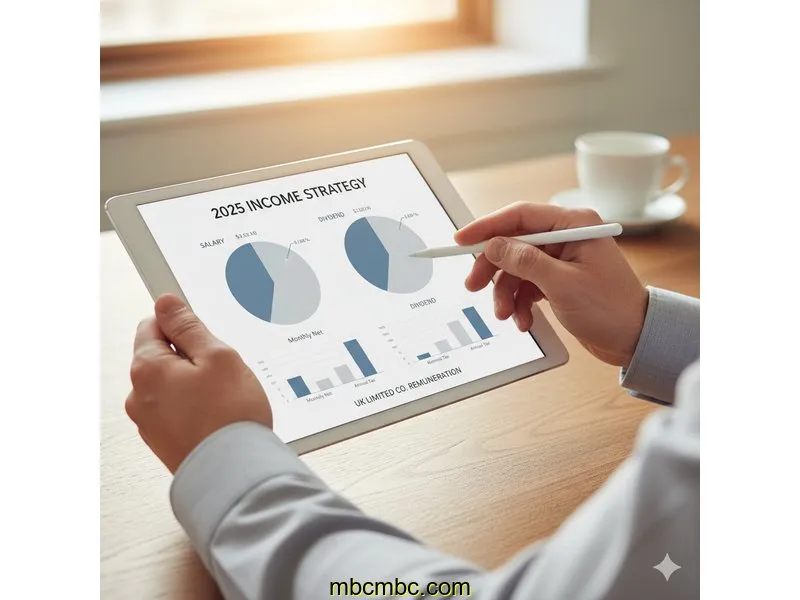
If you've recently set up your own UK limited company, congratulations! You've navigated the first set of hurdles. Now comes one of the most common and confusing questions new directors face: "What's the 'best' way to pay myself?" You'll hear terms like "low salary, high dividends" thrown around, but the rules and tax rates seem to shift every year, making it hard to know what's current.
As the developer behind FinTools UK, I've spent a lot of time breaking down these complex calculations. The choice between taking a salary (which is a business expense) and a dividend (which is a distribution of post-tax profit) has a direct impact on your company's Corporation Tax bill and your personal Self-Assessment tax return. The "optimal" mix changes depending on tax thresholds, National Insurance rates, and your personal financial situation.
This guide isn't financial advice; it's an informational breakdown. We'll walk through a clear scenario for the 2025/26 tax year to explain *how* these two payment methods interact, so you can better understand the figures when you speak with your accountant.
Quick Summary: Salary vs. Dividends
Here's the fundamental difference in how these payment methods are treated for tax purposes:
- Salary (via PAYE): This is an allowable business expense. Your company pays it to you *before* calculating its profit, which reduces your Corporation Tax bill. You (and potentially your company) pay National Insurance contributions on it. It's taxed as income via your personal tax code.
- Dividends: This is a distribution of profit. Your company must first calculate and pay Corporation Tax on its profits. Then, you can pay a dividend from the remaining amount. You pay personal Dividend Tax on this via your Self-Assessment, but there is no National Insurance due on dividends.
The Key Taxes and Allowances for 2025/26
To understand the scenarios, we first need to know the key numbers for the 2025/26 tax year (which runs from 6 April 2025 to 5 April 2026).
- Personal Allowance: £12,570. This is the amount of income you can earn before paying any Income Tax.
- Corporation Tax: 25% on profits over £250,000, with tapered relief for profits between £50,000 and £250,000. For simplicity, we'll assume a 19% rate for small profits. (Note: Check the current rate as this can change).
- National Insurance (NI): The "sweet spot" salary is often tied to NI thresholds. Taking a salary up to the **Lower Earnings Limit** (£6,396/year) means you get a 'qualifying year' for your State Pension without actually paying any NI. Taking it up to the **Primary Threshold** (£12,570/year) means you pay no employee NI, but the company pays Employer's NI (13.8%) on salary above £9,100.
- Dividend Allowance: £500. This is a critical change from previous years. You only pay dividend tax on dividends you receive *above* this £500 allowance.
- Dividend Tax Rates:
- 8.75% (for income in the Basic Rate band)
- 33.75% (for income in the Higher Rate band)
- 39.35% (for income in the Additional Rate band)
Why the "Low Salary, High Dividend" Model Exists
The main reason this strategy became popular is **National Insurance**. Dividends are not subject to NI, whereas a salary is (for both employee and employer). This can represent a significant saving.
The common strategy is to pay a small salary, just enough to trigger a qualifying year for the State Pension (i.e., at or just above the Lower Earnings Limit) but low enough to avoid paying NI. This salary is a business expense, so it reduces the company's profit and its Corporation Tax bill.
After that, all remaining funds the director wants to take are paid as dividends from the company's post-tax profits. Even with the cut to the Dividend Allowance (down to just £500 from April 2024), this method often remains more tax-efficient than taking a large salary, purely because of the NI savings.
Scenario Comparison: Salary vs. Dividend Mix in 2025/26
Let's imagine your limited company makes a pre-tax profit of **£60,000** in a year. You are the sole director and employee. Let's compare two simplified scenarios. (Note: These figures are for illustration. We'll use the 19% small profits rate for Corporation Tax and simplified NI thresholds for clarity).
| Metric | Scenario A: Low Salary (£12,570) + Dividends | Scenario B: High Salary (£60,000) |
|---|---|---|
| Company Profit (Pre-Salary) | £60,000 | £60,000 |
| Salary Paid | £12,570 | £60,000 |
| Employer's NI (on salary > £9.1k) | (Approx. £479) | (Approx. £7,024) |
| Taxable Profit (After Salary & NI) | £46,951 | (£7,024) - Company makes a loss |
| Corporation Tax (at 19%) | (Approx. £8,921) | £0 |
| Profit Available for Dividends | £38,030 | £0 |
| Director's Personal Tax | ||
| Gross Pay (Salary + Dividend) | £50,600 (£12.57k + £38.03k) | £60,000 (Salary only) |
| Personal Tax (Income Tax) | £0 (Salary is within Personal Allowance) | (Approx. £11,432) |
| Personal Tax (Dividend Tax) | £3,284 (on £37,530 at 8.75%) | £0 |
| Personal NI (on salary > £12.57k) | £0 | (Approx. £3,044) |
| Total Take-Home Pay (Approx) | £47,316 | £45,524 |
As this simplified scenario shows, the "Low Salary, High Dividend" model (Scenario A) results in a higher net take-home pay for the director. The primary saving comes from avoiding thousands of pounds in both Employer's and Employee's National Insurance contributions, which outweighs the Corporation Tax and personal Dividend Tax paid.
How Calculators Help You Visualise This
Trying to work this out manually is a headache. This is where financial calculators become so useful. A "Salary vs. Dividend Calculator" is designed to run these scenarios instantly.
You can input your expected company profit, and the tool will automatically apply the correct Corporation Tax rates, NI thresholds, and dividend tax bands. It lets you "play" with the numbers—what if I take a £9,000 salary? What if I take a £12,570 salary? The calculator can show you a side-by-side comparison of the total tax paid (Corporation Tax + Income Tax + NI + Dividend Tax) for each mix, helping you see the impact of each decision.
Common Questions About Paying Yourself
When researching this topic, I see the same practical questions pop up on forums like Reddit's r/UKPersonalFinance. Here are a few common ones.
Do I pay dividend tax if my total dividends are under the £500 allowance?
No. The £500 Dividend Allowance for the 2025/26 tax year is a 'zero-rate' band. If your only income was, for example, a £12,570 salary (covered by your Personal Allowance) and £500 in dividends, you would pay no tax on the dividends. You only pay dividend tax on the portion of dividends *above* this £500 limit.
How do I physically pay my dividend tax? Is it deducted automatically?
This is a key difference from PAYE salary. Dividend tax is **not** deducted at source. Your company pays you the 'gross' dividend amount. You are then personally responsible for declaring this dividend income to HMRC and paying the tax owed. This is almost always done via your annual Self-Assessment tax return.
Is it still worth taking dividends over a higher salary with the allowance cut?
As the scenario table above illustrates, in many cases, the answer is yes. The Dividend Allowance cut to £500 (from £1,000, and £2,000 before that) has certainly reduced the tax efficiency, but it hasn't eliminated it. The savings on National Insurance (which can be 13.8% for the employer and 8% for the employee on higher earnings) are still very significant.
Final Thoughts

Choosing how to pay yourself from your own company is a balancing act between business taxes and personal taxes. The "low salary, high dividend" approach remains a common strategy for a reason, as it typically offers a more tax-efficient way to take money out of your business by minimising National Insurance.
However, everyone's situation is different. You may have other income, student loan repayments, or pension contributions that change the calculation. This guide is designed to help you understand the *mechanics* of the calculation. It is always a good idea to use an up-to-date calculator to model your specific numbers and to discuss your remuneration strategy with a qualified accountant.

